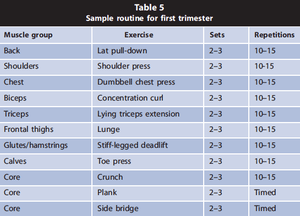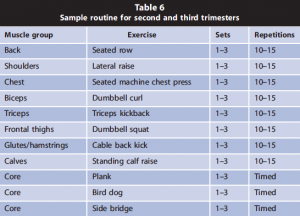How to Safely Exercise When Pregnant
Remaining active during a pregnancy may help reduce some discomforts and help prepare the body for delivery. Acute exercise generally increases oxygen uptake, heart rate, stroke volume, cardiac output, and lung volume during pregnancy. Remember to complete the “PARmed-X for Pregnancy” health screening prior to participation in a prenatal fitness class or other exercise. Medical clearance should be obtained prior to exercise for women who were sedentary prior to pregnancy or have a medical condition.
 Benefits:
Benefits:
- reduced backaches
- reduced constipation and bloating
- may help prevent gestational diabetes
- improved weight management
- increase in energy
- improved mood
- improved posture
- better sleep patterns
- development of muscle tone
- promotes strength and endurance
- better coping with labour
Contraindications to Exercise:
Absolute Contraindications:
- hemodynamically significant heart disease
- restrictive lung disease
- incompetent cervix/cerciage
- multiple gestation at risk for premature labour
- persistent second or third trimester bleeding
- placenta prevue after 26th week of gestation
- premature labour during current pregnancy
- ruptured membranes
- preeclampsia/pregnancy-induced hypertension

 Relative Contraindications:
Relative Contraindications:
- severe anemia
- unevaluated maternal cardiac dysrhythmia
- chronic bronchitis
- poorly controlled Type 1 diabetes mellitus
- extreme morbid obesity
- extreme underweight
- history of extremely sedentary lifestyle
- intrauterine growth restriction in current pregnancy
- poorly controlled hypertension
- orthopaedic limitations
- poorly controlled seizure disorder
- poorly controlled hyperthyroidism
- heavy smoker
 Warning Signs to Terminate Exercise Session
Warning Signs to Terminate Exercise Session
- vaginal bleeding
- dyspnea before exertion
- dizziness
- headache
- chest pain
- muscle weakness
- calf pain or swelling
- preterm labour
- decreased fetal movement
- amniotic fluid leakage
Exercise Recommendations:
Aerobic Exercise
 Intensity: Moderate intensity exercise is encouraged for women with a pre-pregnancy body mass index (BMI) of less than 25 kg per squared meter. However, women with a pre-pregnancy BMI of greater than 25 kg per squared meter should engage in light intensity exercise.
Intensity: Moderate intensity exercise is encouraged for women with a pre-pregnancy body mass index (BMI) of less than 25 kg per squared meter. However, women with a pre-pregnancy BMI of greater than 25 kg per squared meter should engage in light intensity exercise.






